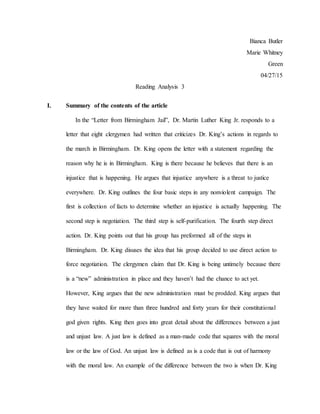
Reading Analysis 3 460
- 1. Bianca Butler Marie Whitney Green 04/27/15 Reading Analysis 3 I. Summary of the contents of the article In the “Letter from Birmingham Jail”, Dr. Martin Luther King Jr. responds to a letter that eight clergymen had written that criticizes Dr. King’s actions in regards to the march in Birmingham. Dr. King opens the letter with a statement regarding the reason why he is in Birmingham. King is there because he believes that there is an injustice that is happening. He argues that injustice anywhere is a threat to justice everywhere. Dr. King outlines the four basic steps in any nonviolent campaign. The first is collection of facts to determine whether an injustice is actually happening. The second step is negotiation. The third step is self-purification. The fourth step direct action. Dr. King points out that his group has preformed all of the steps in Birmingham. Dr. King disuses the idea that his group decided to use direct action to force negotiation. The clergymen claim that Dr. King is being untimely because there is a “new” administration in place and they haven’t had the chance to act yet. However, King argues that the new administration must be prodded. King argues that they have waited for more than three hundred and forty years for their constitutional god given rights. King then goes into great detail about the differences between a just and unjust law. A just law is defined as a man-made code that squares with the moral law or the law of God. An unjust law is defined as is a code that is out of harmony with the moral law. An example of the difference between the two is when Dr. King
- 2. discusses the reason he is in jail. He was arrested on the charge of parading without a permit. King argues that the law itself in just but the way that the law was used in this case is unjust because it was used as an attempt to silence the movement, rather than to ensure the safety of the people. II. Identifying the authors main theme(s) or thesis Race and equality is the main theme in Dr. King’s letter. Race and equality are important because both letters talks about race and equality. The clergymen states that “hatred and violence have no sanction in our religious and political traditions.” However, this has not been the case. Justice and injustice is another one. The clergymen believed that the way the police and community handled the protest and jailing of the people involved was just. However, Dr. King believed that it unjust how the police used the dogs to attack the protestors for their nonviolent resistance. III. Evaluating how effectively the author expresses goals or supports the thesis with strong details and evidence Dr. King accomplishes his goal in this letter. His goal was to rebut the criticisms that the clergymen presented in their letter. He did this by creating a well-reasoned argument that refuted all of the clergymen claims. His other goal was to answer the clergymen’s letter in patient and reasonable terms. He did not personally attack the clergymen and was not mad at the clergymen for what they had said in their letter. King simply wanted to promote understanding of the African American cause. In short, he wished to educate the clergymen. We believe that Dr. King supported the validity of his thesis by using undeniable real-life examples and facts. He used a lot of first hand examples that are difficult to refute and lend validity to his claims. Dr.
- 3. King’s argument about how his group followed the nonviolent campaign four basic steps lends credibility to the letter because it shows that the movement has a logical progression. IV. Personal critical remarks We believe that Dr. King wrote this letter with intellectual insight. In the letter, Dr. King works very hard to refute the claims made by the eight clergymen. The thoroughness that Dr. King refutes the clergymen’s claims is what really stands out in this letter. We also like how Dr. King referred to himself as an extremist, stating that Jesus Christ, Paul, Abraham Lincoln and Thomas Jefferson were all extremists. Dr. King uses a lot of descriptive language in his letter especially when he gives the example of an individual who has to explain to their child the reason why the child cannot go to Funtown (an amusement park advertised on television) because the child has the “wrong” skin color. Another example of Dr. King’s descriptive language was when he discuss the idea that an African American person’s first name becomes “nigger”, their middle name becomes “boy”, and their last name becomes “John” and how the mother and wife are never given the respected title “Mrs.” In addition, we like how Dr. King states that “injustice anywhere is a threat to justice everywhere.” This idea permeates the entire letter and sets the tone for the rest of the movement.